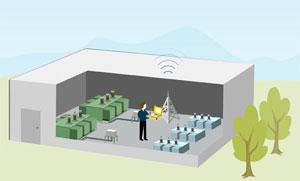 General Electric executives have spent the past year talking up the “Industrial Internet,” in which old-school technologies such as assembly lines are studded with sensors and supported by cutting-edge data analytics. But for much of that time, it was difficult to tell just how much the conglomerate would commit to the initiative. The eventual answer: a whole lot. GE has partnered with AT&T, Cisco, and Intel on its “Industrial Internet” initiative—adding to existing alliances with Amazon Web Services (AWS), Pivotal and Accenture. That’s in addition to launching new Big Data products such as the new Grid IQ Insight, an analytics program designed to filter the immense amounts of data generated by utility companies; the platform faces significant competition in the burgeoning arena of utility analytics from Oracle and other players, all of whom are interested in promoting “smart grid” initiatives. Grid IQ Insight digests raw information related to everything from renewable energy sources to weather history and grid performance; in keeping with the broader “Industrial Internet” theme, the software works best in conjunction with “intelligent machines” capable of feeding a continuous stream of data to an analytics package. But that’s just one of the GE analytics apps launched over the past year, with doubtlessly more to come. Other tools include the Proficy Monitoring & Analysis software suite, which includes Proficy Historian HP, which leverages the ultra-popular Apache Hadoop framework to analyze massive amounts of data stored on clusters. As of June, GE was wrestling with 5TB of new time-series data per day. That would be an incredible strain on any system, and it’s probably driving the company’s analytics innovations. But will its partners devote the same level of resources and attention to making the world’s industrial processes “smarter”? There’s certainly ample reason for them to do so. Cisco, AT&T and other firms that build out networks and infrastructure would stand to benefit from a need for next-generation hardware capable of collecting and transmitting immense amounts of data; companies such as Amazon would similarly profit from all that data sloshing through their datacenters and associated analytics toolsets. And if GE could position itself as the orchestra conductor for those players, it would stand to perhaps make the most of all. Whether industrial concerns would embrace still more sensors and analytics as an integral part of their collective process, though, remains the biggest mystery. Image: SasinT/Shutterstock.com
General Electric executives have spent the past year talking up the “Industrial Internet,” in which old-school technologies such as assembly lines are studded with sensors and supported by cutting-edge data analytics. But for much of that time, it was difficult to tell just how much the conglomerate would commit to the initiative. The eventual answer: a whole lot. GE has partnered with AT&T, Cisco, and Intel on its “Industrial Internet” initiative—adding to existing alliances with Amazon Web Services (AWS), Pivotal and Accenture. That’s in addition to launching new Big Data products such as the new Grid IQ Insight, an analytics program designed to filter the immense amounts of data generated by utility companies; the platform faces significant competition in the burgeoning arena of utility analytics from Oracle and other players, all of whom are interested in promoting “smart grid” initiatives. Grid IQ Insight digests raw information related to everything from renewable energy sources to weather history and grid performance; in keeping with the broader “Industrial Internet” theme, the software works best in conjunction with “intelligent machines” capable of feeding a continuous stream of data to an analytics package. But that’s just one of the GE analytics apps launched over the past year, with doubtlessly more to come. Other tools include the Proficy Monitoring & Analysis software suite, which includes Proficy Historian HP, which leverages the ultra-popular Apache Hadoop framework to analyze massive amounts of data stored on clusters. As of June, GE was wrestling with 5TB of new time-series data per day. That would be an incredible strain on any system, and it’s probably driving the company’s analytics innovations. But will its partners devote the same level of resources and attention to making the world’s industrial processes “smarter”? There’s certainly ample reason for them to do so. Cisco, AT&T and other firms that build out networks and infrastructure would stand to benefit from a need for next-generation hardware capable of collecting and transmitting immense amounts of data; companies such as Amazon would similarly profit from all that data sloshing through their datacenters and associated analytics toolsets. And if GE could position itself as the orchestra conductor for those players, it would stand to perhaps make the most of all. Whether industrial concerns would embrace still more sensors and analytics as an integral part of their collective process, though, remains the biggest mystery. Image: SasinT/Shutterstock.com GE Partnering Up for ‘Industrial Internet’ Push
 General Electric executives have spent the past year talking up the “Industrial Internet,” in which old-school technologies such as assembly lines are studded with sensors and supported by cutting-edge data analytics. But for much of that time, it was difficult to tell just how much the conglomerate would commit to the initiative. The eventual answer: a whole lot. GE has partnered with AT&T, Cisco, and Intel on its “Industrial Internet” initiative—adding to existing alliances with Amazon Web Services (AWS), Pivotal and Accenture. That’s in addition to launching new Big Data products such as the new Grid IQ Insight, an analytics program designed to filter the immense amounts of data generated by utility companies; the platform faces significant competition in the burgeoning arena of utility analytics from Oracle and other players, all of whom are interested in promoting “smart grid” initiatives. Grid IQ Insight digests raw information related to everything from renewable energy sources to weather history and grid performance; in keeping with the broader “Industrial Internet” theme, the software works best in conjunction with “intelligent machines” capable of feeding a continuous stream of data to an analytics package. But that’s just one of the GE analytics apps launched over the past year, with doubtlessly more to come. Other tools include the Proficy Monitoring & Analysis software suite, which includes Proficy Historian HP, which leverages the ultra-popular Apache Hadoop framework to analyze massive amounts of data stored on clusters. As of June, GE was wrestling with 5TB of new time-series data per day. That would be an incredible strain on any system, and it’s probably driving the company’s analytics innovations. But will its partners devote the same level of resources and attention to making the world’s industrial processes “smarter”? There’s certainly ample reason for them to do so. Cisco, AT&T and other firms that build out networks and infrastructure would stand to benefit from a need for next-generation hardware capable of collecting and transmitting immense amounts of data; companies such as Amazon would similarly profit from all that data sloshing through their datacenters and associated analytics toolsets. And if GE could position itself as the orchestra conductor for those players, it would stand to perhaps make the most of all. Whether industrial concerns would embrace still more sensors and analytics as an integral part of their collective process, though, remains the biggest mystery. Image: SasinT/Shutterstock.com
General Electric executives have spent the past year talking up the “Industrial Internet,” in which old-school technologies such as assembly lines are studded with sensors and supported by cutting-edge data analytics. But for much of that time, it was difficult to tell just how much the conglomerate would commit to the initiative. The eventual answer: a whole lot. GE has partnered with AT&T, Cisco, and Intel on its “Industrial Internet” initiative—adding to existing alliances with Amazon Web Services (AWS), Pivotal and Accenture. That’s in addition to launching new Big Data products such as the new Grid IQ Insight, an analytics program designed to filter the immense amounts of data generated by utility companies; the platform faces significant competition in the burgeoning arena of utility analytics from Oracle and other players, all of whom are interested in promoting “smart grid” initiatives. Grid IQ Insight digests raw information related to everything from renewable energy sources to weather history and grid performance; in keeping with the broader “Industrial Internet” theme, the software works best in conjunction with “intelligent machines” capable of feeding a continuous stream of data to an analytics package. But that’s just one of the GE analytics apps launched over the past year, with doubtlessly more to come. Other tools include the Proficy Monitoring & Analysis software suite, which includes Proficy Historian HP, which leverages the ultra-popular Apache Hadoop framework to analyze massive amounts of data stored on clusters. As of June, GE was wrestling with 5TB of new time-series data per day. That would be an incredible strain on any system, and it’s probably driving the company’s analytics innovations. But will its partners devote the same level of resources and attention to making the world’s industrial processes “smarter”? There’s certainly ample reason for them to do so. Cisco, AT&T and other firms that build out networks and infrastructure would stand to benefit from a need for next-generation hardware capable of collecting and transmitting immense amounts of data; companies such as Amazon would similarly profit from all that data sloshing through their datacenters and associated analytics toolsets. And if GE could position itself as the orchestra conductor for those players, it would stand to perhaps make the most of all. Whether industrial concerns would embrace still more sensors and analytics as an integral part of their collective process, though, remains the biggest mystery. Image: SasinT/Shutterstock.com 
